Thanksgiving, 1921 Centre-Tulane
The Thanksgiving date had been in a state of flux all season. Centre's traditional opponent, at least for the past 5 years, was Georgetown. The Colonels and Tigers first played in 1898, and the Thanksgiving date was adopted in 1916. Even in the war-shortened 1918 season, the two teams had met on the last Thursday of November.
However, Centre received word that Georgetown had decided to call off the game after the schedule had been made out for 1921. It was obvious that the two schools, so recently at parity, had gone their separate ways regarding skill levels on the gridiron.
Therefore, the backup plan was to play DePauw in Indianapolis. The 1920 game there with the Tigers had been a big success financially for the Indiana school even though DePauw had lost to the Colonels, 34-0. To its surprise, Centre received communications from DePauw that there was worry about the game generating enough revenue to cover the expenses which would be incurred.
That made no sense to the Chief. The previous year's contest had been a sellout, and the 1921 game would generate the same type of revenue. Nonetheless, DePauw wanted out, Tulane heard about it, and an offer came up from New Orleans that Centre found satisfactory. So it was off to New Orleans to play the Tulane "Green Wave."
![Jambalaya [yearbook] 1922](https://centrewonderteam.com/wp-content/uploads/2023/10/image_1681.jpg)
Tulane 1921
Anyway, Centre figured New Orleans in late November was better than Indianapolis, and it would be a new experience to visit the Crescent City. Other than Minos Gordy from Abbeville, Louisiana, none of the Colonels had been to New Orleans before.
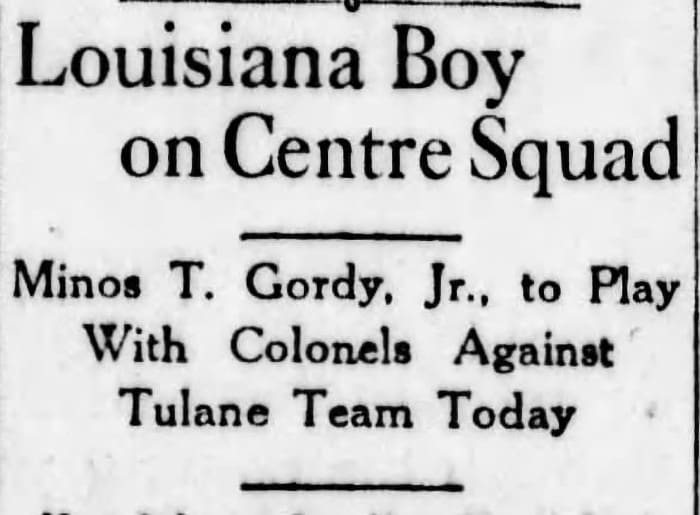
The Chief and Uncle Charlie had always felt that football was a great way to allow the players on their teams to see the country. Many of the Kentuckians had never been out of the state before their travels with the squad. A good example was George Chinn. George was from a prominent family from Harrodsburg, Kentucky and first left the state when the train taking the team to the 1920 Harvard game crossed the Ohio River and entered Cincinnati.
The trip to New Orleans was going to require a quick turnaround. The team didn't arrive back from Louisville after the W&L game until Sunday afternoon on November 20, and was to pull out of Danville and head south at 10:55 A.M. on the 22nd, Tuesday.
The Southern left two Pullmans on the siding in Danville, one for the team and one for the fans. They were hooked onto the regularly scheduled Cincinnati-New Orleans "Limited." The first part of the trip carried the train from Danville through what was nicknamed the "The Rat Hole" which was given that rather undistinguished designation due to its numerous tunnels which made the journey reminiscent of a rat's digging through a subterranean route. After getting past Oakdale in the southern part of Morgan County in Tennessee, the journey south required the big steamer to go to and through Chattanooga, on to Birmingham, and then cross over the Mississippi state line to Meridian.
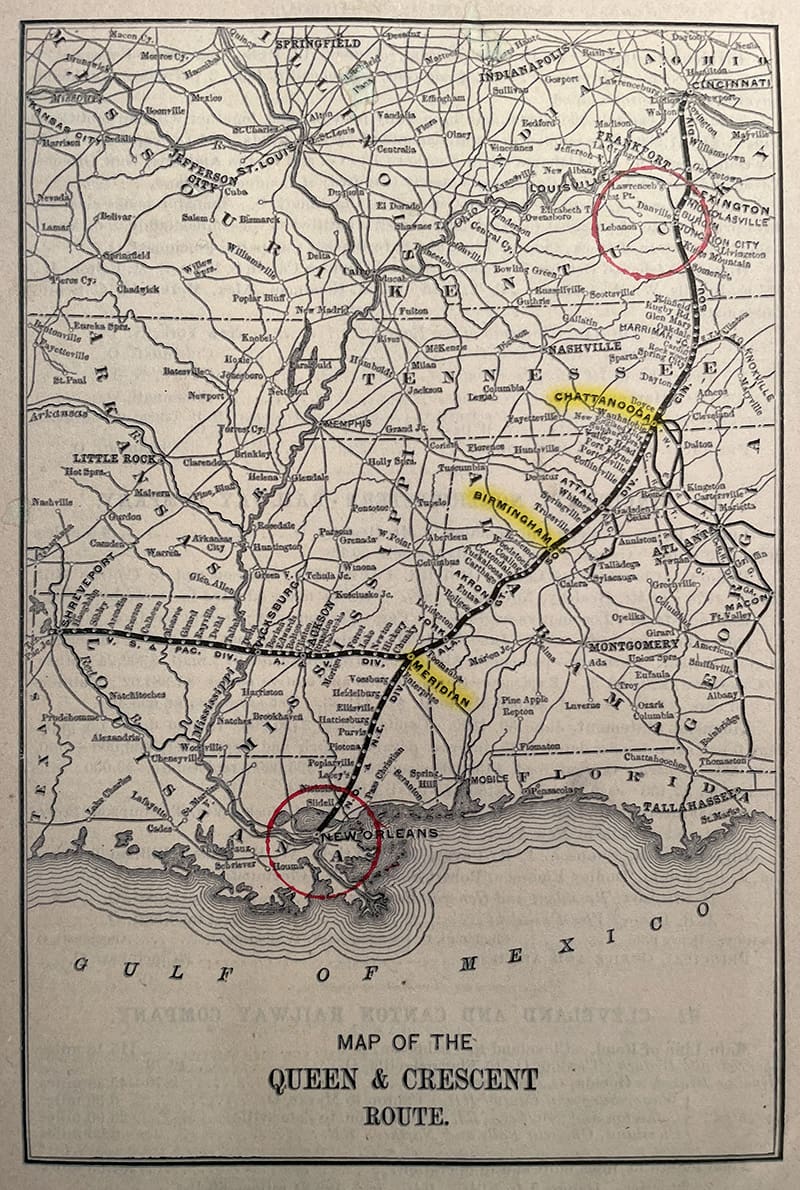
Southern Railroad's Queen ( Cincinnati ) and Crescent ( New Orleans ) route. The Centre Pullman's were hooked on at Danville.
From Meridian, it was another 6 ½ hours before the "Limited" braked to a halt at the New Orleans Southern Station, a $260,000 cavernous Beaux-Arts building completed in 1908 and designed by the renowned Chicago architect, Daniel H. Burnham, who also designed the famous Flatiron Building in New York, Union Station in the nation's capital, and much of Chicago.
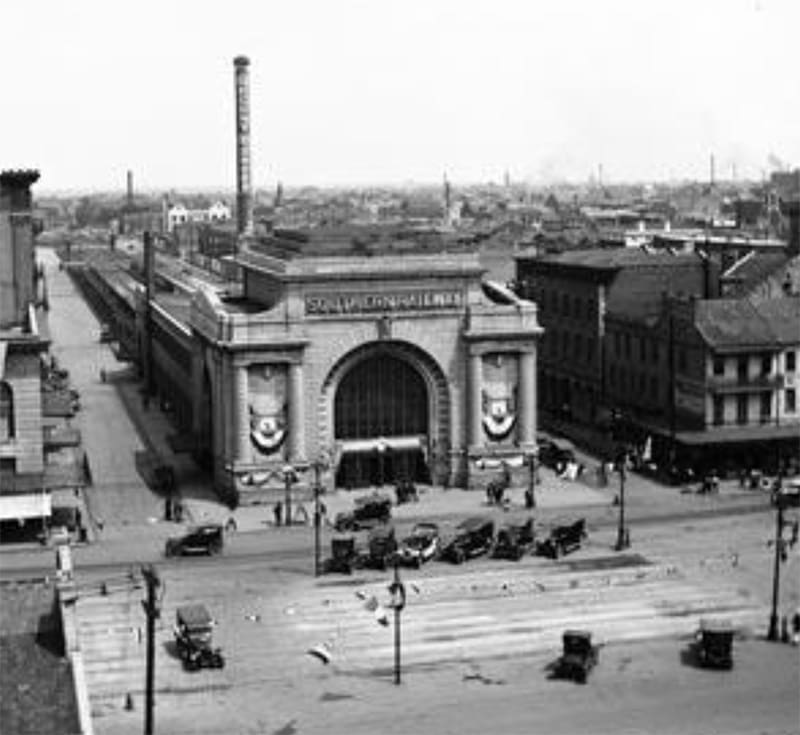
Southern Railroad Station at 1125 Canal Street in New Orleans. It was demolished in 1956 after all passenger service was relocated to the new Union Passenger Terminal.
It had been a pleasant journey for the team, watching the scenery flash by, playing cards, eating meals in the dining car, sleeping overnight, and arriving fresh and ready to go, nearly 24 hours later, at 9:55 Wednesday morning in a city where the temperature was hovering around 70 degrees.
As always, the Colonels were met by a warm reception. After meeting with the welcoming committee and reporters, they were quickly on their way for a workout at Heinemann Park, opened in 1915, also known as Pelican Park, home of the New Orleans Pelicans, a Southern Association AA minor league baseball team.
F. Edward Hebert was a Tulane student who was the sports editor of the school's newspaper, the "Hullabaloo." He also covered the college's sports for the New Orleans "Times-Picayune."
The young reporter filed a story for the city newspaper after attending the Colonels' workout, and it is one of the most descriptive in pointing out exactly what made the team's offense so effective, and so hard to defend.
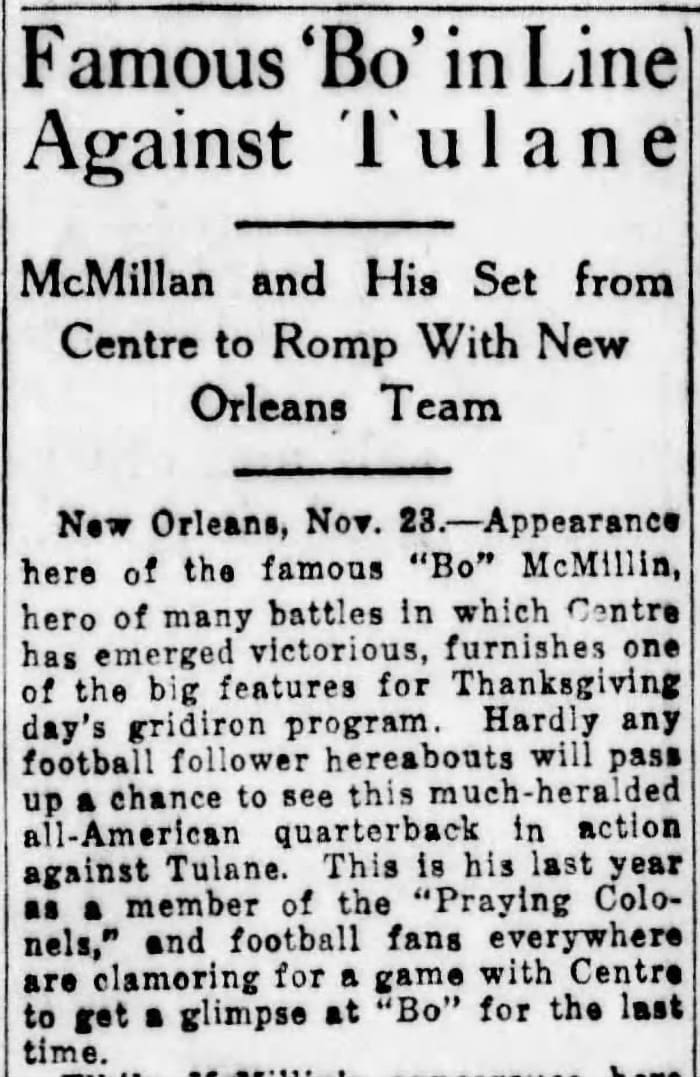
Report In the New Orleans "Times-Picayune"
The "Wonder Team," as the Centre College outfit has often been described, is certainly well named after what we saw yesterday at Heinemann Park. To the mere casual onlooker, the Centre team seems nothing more than a bunch of men dressed up in some gold sweaters striped in white. They do not seem an extraordinary group of players, nor do they appear to be greater than the average run of football teams.
But what a change when those boys get into action in signal practice! If they play just one half as well against a team as they run signals, then a real football game is going to be the order of the day. We never have seen such a marvelous squad as the Centre team of yesterday afternoon.
One has often heard tell of magicians who claim that the hand is quicker than the eye.
And from what we saw yesterday, we are of the opinion that the whole Centre outfit is composed of a bunch of magicians. The plays of the Colonels are absolutely the most baffling and dazzling ever seen on a New Orleans gridiron. It is a treat to stand on the sidelines and watch the Kentuckians run through their plays.
On some formations ( and they have them to the nth degree ) one cannot see just who is carrying the oval. The interference is wonderful, and it is going to take a mighty good team to stop the boys from the Bluegrass.
Bo McMillin and Red Roberts, the two real big stars of the team, are perhaps the most unconcerned men on the entire squad. The average fan would pick neither of these players as stars. But what a change comes over them when they start calling out signals and warming up. The sound of a signal seems to awaken them as a bugle does a soldier, and then some real football starts.
Tulane's campus is all astir over the approaching contest. While no one says openly that Tulane is going to defeat the greatest team in America, some students believe that Tulane will score on Centre, which seems to be placing a lot of confidence in the members of the "Olive and Blue."
( The "Olive and Blue" nickname was adopted in 1893 and carried over even after Tulane became known as the "Green Wave" in 1920. )
The Colonels were now causing speculation about whether a team could even score on them. Defeating them seemed not to enter the equation.
The same day's "Times-Picayune" had a large composite picture taken at Heinemann Park under the heading:
THE MIGHT AND BRAIN OF THE PRAYING COLONELS
The "Might" was represented by Bo, Red, Army, Louisiana's Minos Gordy, and Terry Snowday.
The "Brain" was represented by, "The two in citizen's clothes," Uncle Charlie and Tiny Thornhill.
The caption under the entire photograph read, "The Praying Colonels are perhaps the greatest collection of football players in the entire country."
Tulane came into the game with a 4-4 record.
Tulane 0 Mississippi College 14
Tulane 26 Mississippi 0
Tulane 7 Rice 6
Tulane 7 Mississippi State 0
Tulane 10 University of Detroit 14
Tulane 0 Auburn 14
Tulane 6 Washington U. ( Mo.) 14
Tulane 21 LSU 0
The key to the strength of Tulane was the shutout they put on a strong LSU Tigers team. The Tigers had an excellent season, going 6-1-1, with their only defeat being against Tulane. LSU had beaten a strong Texas A&M team, 6-0. ( The tie was with Alabama.)
Tulane had 3 standout players who were featured in a "Times-Picayune" photograph prior to the game. However, despite the Green Wave having a decent team, if the caption is read closely, it was apparent that Centre wasn't expected to have have much trouble during the Thanksgiving contest.

Despite featuring three stars from Tulane, "On dope the Colonels should experience little trouble....." according to the caption.
Auburn was a common opponent of Tulane and Centre, and comparable scores would indicate that Centre was the better team. Centre beat Auburn 21-0 and Tulane lost to the Tigers, 14-0.
The game was to be played in Tulane Stadium, a reinforced concrete structure, covered with stucco, built in 1917.
( Tulane's stadiums are known as Tulane I, II, and III. The first was a wooden structure, built in 1909, but it was soon outgrown. Tulane II, where the Centre game was played, was on McAlister Drive, and dedicated on October 27, 1917. It held 11,000 people. Tulane III was built in 1926 and was the stadium which eventually was known as the Sugar Bowl, and had a capacity of 80,000. Sadly, it was demolished in 1980. )
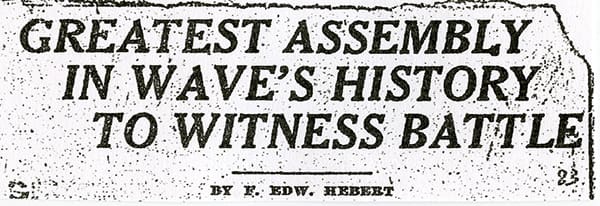
It was 70 degrees at game time. There were over 10,000 fans who had come from all over the South to see the famous Colonels. A band had been hired by Tulane to sit in the Kentucky section to play "Kentucky music" for Centre's team and fans.

In an unusual display for an opposing team, the entire crowd stood and cheered lustily when the Colonels came onto the field, and their greeting was only intensified as the band blared out "Dixie." It was for the South they were cheering. Centre had taken on the mighty Easterners and been victorious. Centre had represented everyone below the Mason-Dixon Line, and the whole region had exploded with pride when the news was heard.
"Centre beat Harvard! Did you hear? Centre beat Harvard!"
"The South will rise again!"
When the band played "My Old Kentucky Home," everyone again stood and cheered, rebel yells and all.
The Tulane game was a virtual replay of the Auburn and W&L contests. The outcome was never in doubt. No one wanted to belittle the Colonels' opponents. The reporters friendly to Centre always made a point of writing about the "courage" of those who lined up against Uncle Charlie's warriors.
The players always complimented their opponents, and were very humble about their superiority. But there was no getting around the story that the figures, when the analyses were made, told about the skill levels of the Colonels and the teams they played against during this era.
A "special dispatch" to the "Courier-Journal" was printed under the headline:
MORAN'S MEN OUTCLASS TULANE GRIDDERS IN HOT WEATHER
New Orleans, La., Nov. 24- Centre triumphed over two opponents today, Tulane and the torpid weather. The final score was 21-0. The weather was 70 degrees at the kickoff.
The Colonels, playing in their usual fashion, outclassed the Green Wave in every department, gaining 477 yards to Tulane's 135. Centre registered 24 first downs while the local outfit could gain but 2.
So now in the last 4 games against Kentucky, Auburn, Washington & Lee and Tulane, Centre's opponents had only 14 first downs in 16 quarters of play.
"Unbelievable!" is what the sports columnists of the day declared.
Bo and the Colonels completed 14 of 18 passes for 183 yards, an average of 13 yards per successful toss, with no interceptions. Tulane only attempted 3 passes. Two were intercepted and the other fell incomplete.
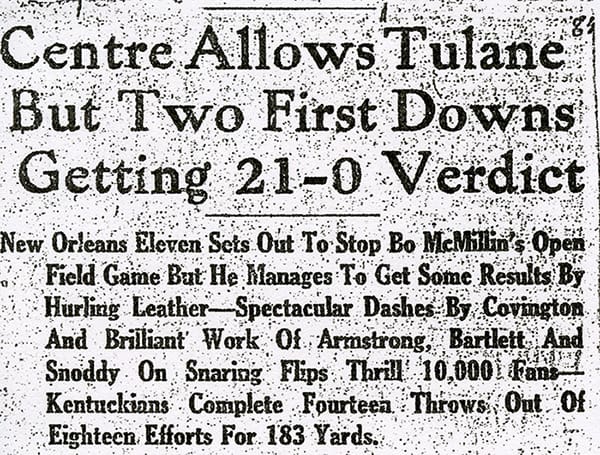
The 8th shutout of the season in which Centre had only allowed that touchdown against St. Xavier due to a fumble recovery in the end zone
The first touchdown came on the initial possession by the Colonels. The long gainers were a 22-yard pass from Bo to Army, a 9 -yard, end-around by Bo, and a 16-yard touchdown pass to Tom Bartlett from Bo.
Tulane made one of its first downs to start the 2nd quarter. During the period, Centre racked up 161 yards to the Green Wave's 33.
Centre's 2nd score came on a pass from Bo to Terry Snowday which was described as- Bo hurled a 15-yard pass to Snowday. Taking the ball on the 15-yard line, Snowday twisted out of the grasps of two tacklers and did a somersault over a stack of players, landing beyond the goal.
Bo's second successful kick made it 14-0 at the half.
Herb Covington made several long runs in the 1st half and picked up some big yardage on punt returns.
As the players retired to the dressing rooms at the half, the crowd stood and cheered the play of the Colonels.
A local fan was quoted as saying that he normally attended the opening day of the horse races at Jefferson Park, as was the tradition in New Orleans amongst the "sporting set," but, "I can go to the track any day. But this is my only chance to see the greatest group of athletes ever to play football in the history of the game. I wouldn't have missed being here for anything."
Many in the crowd expressed the same sentiment.
Centre couldn't punch it in during the 3rd quarter despite several long and sustained drives.
In the last period, Bo put on a passing exhibition and then capped off the effort by faking a pass and twisting through the line from the 3. His extra point ended the scoring.
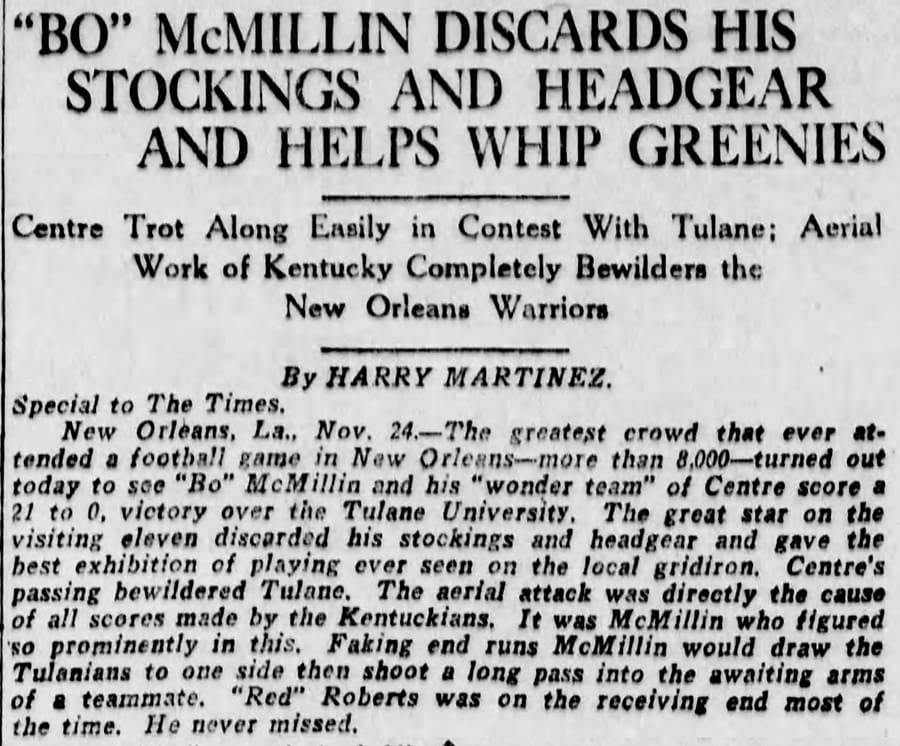
Bo makes a tremendous impression
After the game, the Tulane alumni hosted a party for the team at a theater in the French Quarter, followed by a banquet at the famous la Louisiane Restaurant on Iberville Street, known for its French Creole cuisine.
